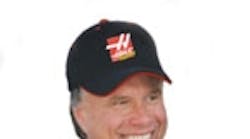The following was overheard at Haas Automation Inc., Oxnard, Calif., recently: "Make machine tools in China? . . . And miss the bargain rates on all the empty cargo containers returning to China?"
Behind that quip is a lot more than the company's policy of making everything at its Oxnard, Calif., headquarters. While manufacturing is local, customers are global. Its business model is built on management's intimate involvement with product, process and technology -- enough to establish and grow a global leadership position via customer value and even enough to be emulated by (gasp) some Japanese manufacturers! (The company refers to its relentless pursuit of excellence as "The Haas Way.") Gene Haas, president and owner, readily admits that he didn't set out to become a machine tool manufacturer -- much less a global leader.
Gene Haas
In the early 1980s, Gene Haas was already "paddling his own canoe" by operating a machine shop called Pro-Turn Engineering in Sun Valley, Calif. It was basically him and a couple of machine operators who ran production parts for the aerospace industry. They specialized in machining parts that many other shops turned away because of their complexity. Satisfying those customers rapidly led to new ones via the following series of defining events:
- The founding of Haas Automation Inc. in 1983.
- The debut of the first Haas CNC machining center at IMTS in 1988.
- The building, sales and shipment of 10,000 machine tools in one year (2005), a record increase of more than 22% over 2004 and more than 200% over 2003.
- The milestone shipment of the company's 50,000th machine tool in 2005. The CNC machine, a SL-20APL turning center with an automatic parts loader was sold to Western Saw, an Oxnard, Calif., neighbor that now has five Haas machines.
How did Pro-Turn Engineering, a job shop, become the global leader, by unit volume, of CNC machine tools?
In the 1980s one of the jobs Gene Haas and his machine operators were running required indexing a part with a manual 5C collet head, which was time consuming and labor intensive. Gene thought there had to be a better way to run the job, so he began developing the first fully programmable automatic 5C collet indexer. He became his own customer.
At times, Gene entertained the idea of using someone else's control, but costs were too high. So he called his old school buddy Kurt Zierhut, who happened to be an electrical engineer, and together they came up with the first version of what is still called "the black box" -- the Haas rotary control. (Zierhut later designed the Haas CNC controls and currently serves as director of electrical engineering.)
Gene built a few of his indexers and put them into the hands of friends and acquaintances at other machine shops for real-world testing, asking only for feedback in return. Everybody loved them and thought they were a great way to increase productivity on manual machines. When Gene offered the Haas 5C for sale to the general public in 1983 at Westec in Los Angeles, Haas Automation was born.
Constant feedback and suggestions from customers led to the development of more new rotary products and eventually the development of a vertical machining center. At Chicago's IMTS in 1988, Haas introduced the VF-1 a 20-inch x 16-inch vertical machining center priced less than $50,000 -- a major feat.
The passions of winning, racing and machine tools have played important roles in the life of Gene Haas.
By the end of 1997, monthly production of CNC machines exceeded 550 units making Haas the largest unit-volume machine tool builder in America. To accommodate continued growth, a new 200,000-square-foot building was built adjacent to the existing facility. That expanded production lines and increased machine shop capabilities while providing space to house one month's supply of finished machine stock to speed shipments to customers. The expansion brought the total square footage to 620,000 to become the largest single machine tool facility in the U.S. By September 2000, the 25,000th Haas machine tool was in service (in the Chicago area).
Today, Haas Automation manufactures four major product lines -- vertical machining centers, horizontal machining centers, CNC turning centers and rotary tables -- as well as a number of large five-axis and specialty machines. Mountan says employment is about 1,100 and growing. With the largest, most modern machine tool manufacturing facility in the U.S., Mountan says Haas ships more CNC machines per month than any other U.S. producer. He expects that to continue as the company pursues a goal of growing 2005 revenues of $600 million to $1 billion by 2010.
Among machine tool builders, that manufacturing policy means Mountan leverages a unique operating model, one that always seeks to gain maximum strategic value from the manufacturing step. Another example: the Haas policy of emphasizing in-house production when it comes to make-or-buy decisions. For example, Haas doesn't buy CNC controls -- it designs and builds its own, explains Mountan. Haas also builds a competitive edge with its distribution strategy. "Domestically we devised a whole new distribution model, and now we're implementing it globally, including China," says Mountan. He describes the Haas Factory Outlet program as kind of a McDonald's approach for the company's dealer network. The intention is to eliminate inconsistencies in bringing the product to customers such as sales people selling a multitude of different things. With the McDonald's approach, Haas Factory Outlets, regardless of location, conform to a set of best practices that facilitate customer interaction. "In addition to a common marketing approach, the customers experience personnel in Haas uniforms and only Haas products are sold and serviced." Mountan says he knows of no other machine tool builder using the approach.
| IndustryWeek presents Rebuilding U.S. Manufacturing, a year-long series that will focus on case studies and expert advice that executives at U.S. manufacturing companies can use to strengthen their companies. |









